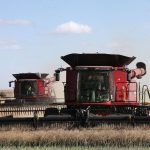Field peas and wheat midds in a creep feeding program can give a profitable boost to nursing calves on native range, according to preliminary data from North Dakota State University’s research extension centre.
Wheat middlings, or midds, are a byproduct of the flour milling industry and consist of fine particles of wheat bran, wheat shorts, wheat germ and wheat flour.
In a study directed by animal scientist Doug Landblom, performance of calves fed various combinations of midds and peas were evaluated against calves that grazed native range with no creep feed. The experimental creep feeds were complete fortified, pelleted diets manufactured at the university’s feed mill.
Read Also

Agriculture ministers agree to AgriStability changes
federal government proposed several months ago to increase the compensation rate from 80 to 90 per cent and double the maximum payment from $3 million to $6 million
“The study suggests the field pea component in a field pea-wheat midds creep formulation should not exceed 67 percent,” Landblom said.
The diets were designed to be typical of rations that would have the potential for commercial application. At the 67 percent level, the diets returned nearly $25 (US) per head more than the cost of the diet.
Researchers wanted to learn how much of the field peas and wheat midds calves would eat, how they would work with other feeds, their economic returns, and what effect they would have on forage intake, digestibility, and calf growth and efficiency.
“There is an ample supply of wheat midds in the region and field peas are becoming more available,” Landblom said.
“This study helps identify new market niches for those products and gives livestock producers more options for formulating cost effective diets.”
The experimental creep feeds used salt to limit calves’ intake levels. Experimental diets were fed for 35 days without salt to familiarize the calves with creep feed, followed by a 28-day restriction period in which eight percent salt was added to the pelleted creep feeds. Sixteen percent salt was used in the last 49 days of the study.
Three 19 percent protein creep feed diets were developed. The first contained 33 percent peas and 67 percent midds.
The second contained 67 percent peas and 33 percent midds. The third was 100 percent peas and no midds. Calves on these three diets were compared to a fourth group of nursing calves that also grazed native range but did not receive creep feed.
At the start of the study, and during the creep adjustment phase when no salt was fed, the calves ate roughly 2.7 pounds per head per day. In the middle 28-day phase, when the eight percent salt restriction was applied, daily consumption per calf was nearly four lb. per head per day. When salt was increased to 16 percent, intake per calf was reduced to 2.8 lb. Over the course of the 112-day study, the average daily creep intake per calf was 3.1 lb. per day.
Creep intake across treatments was fairly consistent, ranging from 2.93 lb. per calf in the 33 percent pea group to 3.2 lb. in the 67 percent pea group. Calves receiving a 100 percent pea creep feed consumed three lb. per day for the entire study. Calves on the field pea- midds creep diets grew faster than calves in the non-creep fed control group.
Within field pea-midds treatments, average daily gain for the 33 percent and 100 percent pea creep diets were similar, but less than the 67 percent diet. Average daily gain was 2.08 lb., 2.33 lb., and 1.97 lb. for the 33, 67, and 100 percent field pea-midds treatment groups, respectively. The control group had an average daily gain of 1.65 lb.
Although additional study is needed to confirm results, creep gain per head, average daily creep gain, and creep feed to creep gain efficiency was best for calves on the 67 percent peas and 33 percent midds diet.
Intake in the 100 percent pea creep diet was consistent with the other treatments, but average daily creep gain was lower, resulting in a numerically greater consumption of creep feed per pound of gain.
Cost per head and return over costs were calculated using an average price slide for steer and heifer calves in southwestern North Dakota in November.
The 67 percent pea formulation produced the best return, almost $25 per head, over creep cost. The 33 percent diet gave a $13.33 return while the 100 percent pea diet produced a loss of $4.65.
















